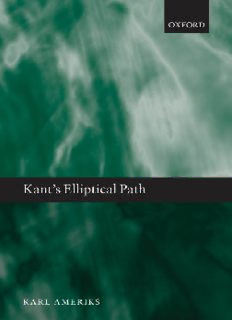
Kant's Elliptical Path PDF
Preview Kant's Elliptical Path
KANT’S ELLIPTICAL PATH This page intentionally left blank Kant’s Elliptical Path KARL AMERIKS CLARENDON PRESS 3 GreatClarendonStreet,Oxford,OX26DP, UnitedKingdom OxfordUniversityPressisadepartmentoftheUniversityofOxford. ItfurtherstheUniversity’sobjectiveofexcellenceinresearch,scholarship, andeducationbypublishingworldwide.Oxfordisaregisteredtrademarkof OxfordUniversityPressintheUKandincertainothercountries #inthisvolumeKarlAmeriks2012 Themoralrightsoftheauthorhavebeenasserted FirstEditionpublishedin2012 Impression:1 Allrightsreserved.Nopartofthispublicationmaybereproduced,storedin aretrievalsystem,ortransmitted,inanyformorbyanymeans,withoutthe priorpermissioninwritingofOxfordUniversityPress,orasexpresslypermitted bylaw,bylicenceorundertermsagreedwiththeappropriatereprographics rightsorganization.Enquiriesconcerningreproductionoutsidethescopeofthe aboveshouldbesenttotheRightsDepartment,OxfordUniversityPress,atthe addressabove Youmustnotcirculatethisworkinanyotherform andyoumustimposethissameconditiononanyacquirer BritishLibraryCataloguinginPublicationData Dataavailable LibraryofCongressCataloginginPublicationData Dataavailable ISBN 978–0–19–969368–9(hbk.) 978–0–19–969369–6(pbk.) PrintedinGreatBritainby MPGBooksGroup,BodminandKing’sLynn LinkstothirdpartywebsitesareprovidedbyOxfordingoodfaithand forinformationonly.Oxforddisclaimsanyresponsibilityforthematerials containedinanythirdpartywebsitereferencedinthiswork. Contents Acknowledgments vii NoteonSourcesandKeytoAbbreviationsandTranslations ix Introduction:OurEllipticalPath 1 PART I. BEFORE THE CRITIQUES: KANT’S UNCOVERING OF OUR FUNDAMENTAL END 1. Kant,HumanNature,andHistoryafterRousseau 29 2. Reality,Reason,andReligionintheEarlyDevelopment ofKant’sEthics 46 PART II. THE CRITIQUES AS A DEFENSE OF A RETURN TO OUR FUNDAMENTAL END FIRST SECTION: THE ELLIPTICAL IMPLICATIONS OF THE CRITIQUE OF PURE REASON 3. Kant’sIdealismonaModerateInterpretation 75 4. OnReconcilingtheTranscendentalTurnandKant’sIdealism 100 5. IdealismandKantianPersons:Spinoza,Jacobi,andSchleiermacher 120 SECOND SECTION: THE ELLIPTICAL IMPLICATIONS OF THE CRITIQUE OF PRACTICAL REASON 6. Kant’sAmbivalentCosmopolitanism 145 7. IsPracticalJustificationinKantUltimatelyDogmatic? 162 8. AmbiguitiesintheWill:KantandReinhold, BriefeII 183 THIRD SECTION: THE CRITIQUE OF THE POWER OF JUDGMENT AND OTHER WRITINGS ON A FINAL PURPOSE 9. ThePurposiveDevelopmentofHumanCapacities 201 10. Kant’sFatefulReviewsofHerder’sIdeas 221 vi Contents 11. TheEndoftheCritiques:Kant’sMoral‘Creationism’ 238 12. KantandtheEndofTheodicy 260 PART III. AFTER THE CRITIQUES: EXTENSIONS OF, AND ALTERNATIVES TO, KANT’S ELLIPTICAL PATH 13. OntheExtensionofKant’sEllipticalPathinHo¨lderlinandNovalis 281 14. Kant,Nietzsche,andtheTragicTurninLateModernPhilosophy 303 15. InterpretationafterKant 324 References 343 Index 359 Acknowledgments I am very pleased to have the chance again to thank the editors of Oxford University Press and especially Peter Momtchiloff for invaluable assistance. Time essential for completion of the volume was made possible by a National EndowmentfortheHumanitiesFellowship,anEarhartFoundationGrant,anda Fellowship at the Notre Dame Institute for Advanced Study. In regard to these grantsIamespeciallyindebtedtoseveralcolleaguesatNotreDame:toKenneth Garcia at the Institute for Scholarship in the Liberal Arts for timely help, to Vittorio Ho¨sle, the Director of the Notre Dame Institute for Advanced Study, as well as his excellent staff and the other Fellows for 2010–11, for their stimulating encouragement, and to the recent chairs of the department of phil- osophy, Stephen Dumont and Richard Cross, for their constant support. I also owespecialthanksforrecentrepeatedphilosophicalassistancefromextraordin- arilyhelpfulcolleaguesnearandfar:RobertAudi,DanBreazeale,PaulGuyer, GaryGutting,ManfredKuehn,RobertPippin,FredRush,andEricWatkins. Forcountlessotheractsofassistance,IremainmoredeeplyindebtedthanIcan everadequatelyexpresstothesupportofkindfriends,students,andassociates. I regret that acknowledgements of help with individual chapters can indicate onlyasmallpartofthisindebtedness.Thanksabovealltomyfamilyfortheir patience, support, and inspiration, especially to Geraldine, and—since the theme of this book very much concerns hope—to the youthful enthusiasm generated by our grandchild, Nolan Quynh Ameriks, whose generation we hope will have the fortunate opportunities of his parents andtheir siblings. Manysectionsofthisbookhaveappearedinanearlierformelsewhere,butall havebeenupdated,withminorcorrectionsandstandardizingofformat,andthe material in Chapters 5 and 14 has been substantively expanded. I gratefully acknowledgethatearlierversionsofthesechaptersinthefollowingpublications are reprinted with permission. ‘Kant, Human Nature, and History after Rous- seau,’ in Kant’s ‘Observations’ and ‘Remarks’: A Critical Guide, Susan Shell and Richard Velkley (eds.) (Cambridge: Cambridge University Press, 2012), 247–65; ‘Reality, Reason, and Religion in the Early Development of Kant’s Ethics,’ in Kant’s Moral Metaphysics: God, Freedom and Immortality, Benjamin J. Bruxvoort Lipscomb and James Krueger (eds.) (Berlin: de Gruyter, 2010), 23–47;‘Kant’sIdealism onaModerate Interpretation,’inKant’sIdealism:New InterpretationsofaControversialDoctrine,DennisSchultingandJaccoVerburgt (eds.) (Berlin: Springer, 2010), 29–54; ‘On Reconciling the Transcendental Turn and Kant’s Idealism,’ in The Transcendental Turn, Sebastian Gardner (ed.) (Oxford: Oxford University Press, (in press)); ‘The Question Is Whether a Purely Apparent Person Is Possible,’ in Spinoza and German Idealism, Eckart viii Acknowledgments Fo¨rster and Yitzhak Melamud (eds.) (Cambridge: Cambridge University Press, 2012), 44–58; ‘Kant’s Ambivalent Cosmopolitanism,’ in Proceedings of the XI International Kant-Congress 2010, vol. 1, Claudio La Rocca etal. (eds.) (Berlin: de Gruyter, 2012), 57–74; ‘Is Practical Justification in Kant Ultimately Dog- matic?’inKantonPracticalJustification,SorinBaiasuandMarkTimmons(eds.) (Oxford: Oxford University Press, 2012, 257–95); ‘Ambiguities in the Will: ReinholdandKant,BriefeII,’inStudiaReinholdiana:TagungsbandderReinhold- Tagung in Siegen 2010, Martin Bondeli and Marian Heinz (eds.) (Berlin: de Gruyter,2012),71–90;‘ThePurposiveDevelopmentofHumanCapacities,’in Kant’s‘IdeaforaUniversalHistorywithaCosmopolitanAim,’AmelieOksenberg Rorty and James Schmidt (eds.) (Cambridge: Cambridge University Press, 2009), 46–67; ‘The End of the Critiques: Kant’s Moral “Creationism”,’ in Rethinking Kant, vol. 1, Pablo Muchnik (ed.) (Newcastle: Cambridge Scholars Press,2008),165–90;‘Tragedy,Romanticism,andIdealism,’inDasNeueLicht derFru¨hromantik:InnovationundAktualita¨tfru¨hromantischerPhilosophie,Ba¨rbel Frischmann and Elizabeth Milla´n-Zaibert (eds.) (Paderborn: Ferdinand Scho¨- ningh, 2008), 28–38; ‘Interpretation after Kant,’ Critical Horizons, 10 (2009): 31–53(#EquinoxPublishingLtd2009). Note on Sources and Key to Abbreviations and Translations References to Kant’s Critique of Pure Reason (Critik der reinen Vernunft, Riga: Hartknoch,1781,1787)aregiveninthestandardwaybycitingthepagesofthe first (‘A’) and/or second (‘B’) edition. Otherwise all references to Kant’s works are cited with the volumeand page number, given in square brackets, ofKant’s gesammelte Schriften, Ausgabe der ko¨niglichen preussischen Akademie der Wis- senschaften(Berlin:WalterdeGruyter,1900–),withabbreviationsforparticular works from List 1 below, which also indicates the relevant English translations. In some references, for convenience, pages in the translation are also provided and are added in the form, ‘in Kant (yyyy, zz),’ indicating the year of the translationfromList2below,andtherelevantpagesintheEnglishversion. LIST 1 KANT’S WRITINGS, BY ABBREVIATIONS USED FOR GERMAN TITLES ANGAllgemeineNaturgeschichteundTheoriedesHimmels(1755)[1:217–368] Universal,NaturalHistoryandTheoryoftheHeavens AnthAnthropologieinpragmatischerHinsicht(1798)[7:119–333],Anthropology from a Pragmatic Point of View, trans. Robert B. Louden, in Kant (2007, 231–429) API Anthropologie Pillau (1777–8) [25: 733–847], Pillau’s ‘Notes on Kant’s AnthropologyLectures’ Auf ‘Beantwortung der Frage: Was ist Aufkla¨rung?’ (1784) [8: 35–42], ‘An Answer to the Question: What Is Enlightenment?,’ trans. Mary J. Gregor in Kant(1996a,17–22) Bem Bemerkungen zu den Beobachtungen u¨ber das Gefu¨hl des Scho¨nen und Erhabenen(1764–65)[20:1–192],‘RemarksintheObservationsontheFeeling of Beautiful and Sublime,’ trans. Thomas Hilgers, Uygar Abaci, and Michael Nance,inKant(2011,65–202);alsoinpartas‘SelectionsfromNotesinthe Observations on the Feeling of Beautiful and Sublime,’ trans. Curtis Bowman, PaulGuyer,andFrederickRauscher,inKant(2005,3–24) Beo Beobachtungen u¨ber das Gefu¨hl des Scho¨nen und Erhabenen (1764) [2: 205–56] Observations on the Feeling of Beautiful and Sublime, trans. John T.Goldthwait,Kant(1960) Bew Der einzig mo¨gliche Beweisgrund zu einer Demonstration des Dasein Gottes (1763)[2:63–163]TheOnlyPossibleArgumentinSupportofaDemonstration
Description: